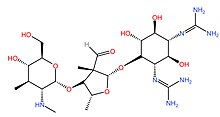Streptomycin
Streptomycin is an aminoglycoside antibiotic, and was the first of these to be discovered in 1943 by Albert Shatz.[1][2][3] The use of streptomycin involves the disruption of protein synthesis within the ribosome, preventing replication of bacteria.[4] It arises from the bacteria Streptomyces griseus and is majorly used in the treatment of infections from aerobic gram-negative bacteria.[1]


Uses
changeStreptomycin has been classified by the World Health Organisation as a critically important antimicrobial for human medicine.[5] The most common use of streptomycin today is the treatment of pulmonary tuberculosis.[1] The antibiotic has a variety of antibacterial activity which is beneficial for the treatment of a wide range of infections.[6] Other infections treated using streptomycin include pneumonia, Mycobacterium avium complex-MAC, E. coli influenza, plague, and tularemia.
Side effects
changeCommon side effects of the use of streptomycin coincide with those seen with the use of other aminoglycoside antibiotics. These include both kidney and ear toxicity, alongside chronic kidney disease.[7] Other dangerous side effects of the use of this drug also include vestibular and auditory system disorders.[8]
Mechanism of action
changeThe use of streptomycin involves the disruption of protein synthesis within the ribosome, preventing the replication of bacteria.[4] The antibiotic creates ionic bonds with the negatively charged sections of the bacterial cell membrane to access the inner cytoplasmic membrane.[9] Streptomycin is only effective against aerobic bacteria as an electron transport system used within the respiratory cycle is needed,[1] however, the antibiotic is able to inhibit both gram-positive and gram-negative bacteria.[10]
References
change- ↑ 1.0 1.1 1.2 1.3 Waters, Mitchell; Tadi, Prasanna (2023), "Streptomycin", StatPearls, Treasure Island (FL): StatPearls Publishing, PMID 32310346, retrieved 2023-06-29
- ↑ Kingston, William (2004-07-01). "Streptomycin, Schatz v. Waksman, and the Balance of Credit for Discovery". Journal of the History of Medicine and Allied Sciences. 59 (3): 441–462. doi:10.1093/jhmas/jrh091. PMID 15270337. Retrieved 2023-07-16.
- ↑ "Streptomycin". American Chemical Society. Retrieved 2023-07-27.
- ↑ 4.0 4.1 Honoré, N; Cole, S T (1994-02-01). "Streptomycin resistance in mycobacteria". Antimicrobial Agents and Chemotherapy. 38 (2): 238–242. doi:10.1128/AAC.38.2.238. ISSN 0066-4804. PMC 284433. PMID 8192450.
- ↑ World Health Organization (2019). Critically important antimicrobials for human medicine (6th rev. ed.). Geneva: World Health Organization. hdl:10665/312266. ISBN 978-92-4-151552-8.
- ↑ "Streptomycin - an overview | ScienceDirect Topics". www.sciencedirect.com. Retrieved 2023-07-08.
- ↑ Prayle, A.; Watson, A.; Fortnum, H.; Smyth, A. (2010-07-01). "Side effects of aminoglycosides on the kidney, ear and balance in cystic fibrosis". Thorax. 65 (7): 654–658. doi:10.1136/thx.2009.131532. ISSN 0040-6376. PMC 2921289. PMID 20627927.
- ↑ Molitor, Hans (1947-04-01). "Pharmacology of Streptomycin". Bull N Y Acad Med. 23 (4): 196–206. PMC 1871547. PMID 19312525.
- ↑ Rocha, Deisy M. G. C.; Viveiros, Miguel; Saraiva, Margarida; Osório, Nuno S. (2021-12-17). "The Neglected Contribution of Streptomycin to the Tuberculosis Drug Resistance Problem". Genes. 12 (12): 2003. doi:10.3390/genes12122003. ISSN 2073-4425. PMC 8701281. PMID 34946952.
- ↑ Schatz, A.; Bugle, E.; Waksman, S. A. (1944-01-01). "Streptomycin, a Substance Exhibiting Antibiotic Activity Against Gram-Positive and Gram-Negative Bacteria.*". Experimental Biology and Medicine. 55 (1): 66–69. doi:10.3181/00379727-55-14461. ISSN 1535-3702. S2CID 33680180.